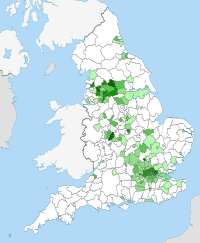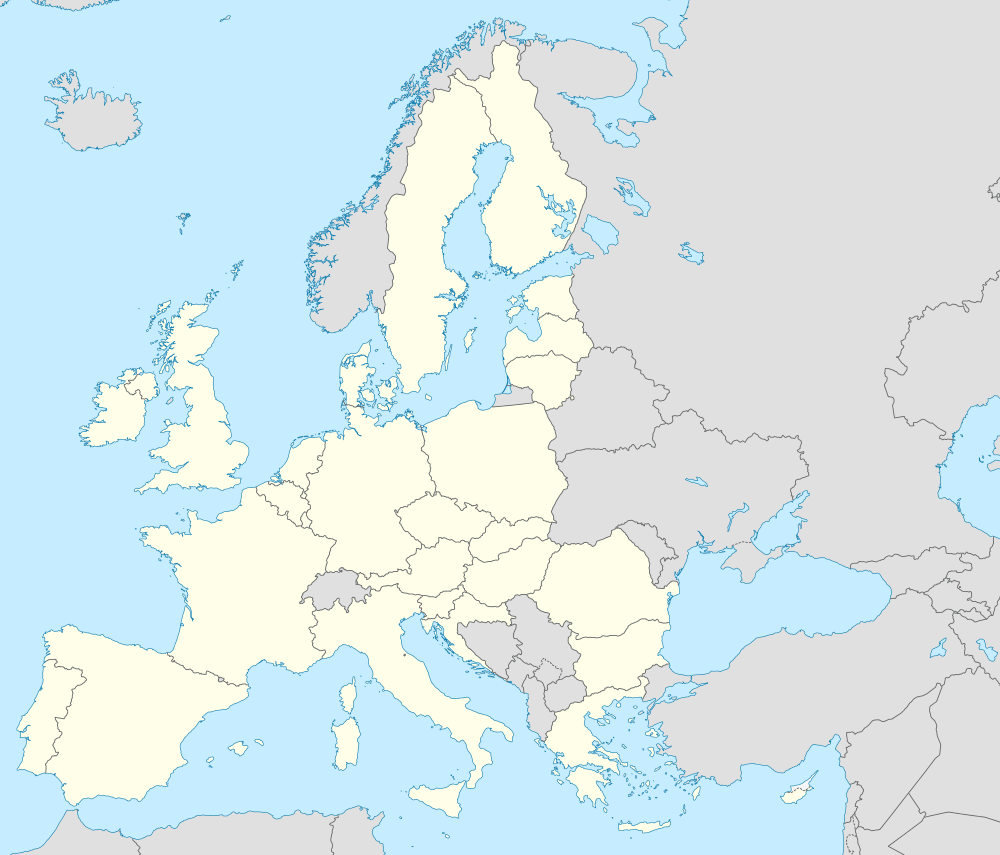List of cities in the European Union by Muslim population
Islam is the fastest-growing major religion in Europe.[1][2]

Since the 1960s, immigrants from Muslim countries started to appear in numbers in Western Europe, especially in Germany, France and Belgium. Although large Muslim communities existed on the continent long before this, especially in the Balkans, this was the first major wave of immigration of Muslims to northwestern Europe.[3]
Muslims in Europe are not a homogeneous group. They are of various national, ethnic and racial identities. The top countries of origin of Muslims in Western Europe are Pakistan, Turkey and the Maghreb countries (Morocco, Algeria, Tunisia).[4] Muslims also vary in terms of their religious commitment: some adhere very strictly to the tenets of Islam while others have largely assimilated into secular European culture.
In Western Europe, Muslims generally live in major urban areas, often concentrated in poor neighborhoods of large cities.[5]
According to the Pew Forum, the total number of Muslims in Europe in 2010 was about 44 million (6%).[6] The total number of Muslims in the European Union in 2010 was about 19 million (3.8%).[6] The French capital of Paris and its metropolitan area has the largest number (up to 1.7 million according to The Economist)[7] of Muslims out of any city in the European Union. London also has a substantial community of Muslim origin, numbering about 1 million within the limits of Greater London and exceeding this figure when the entire metropolitan area is taken into account.
If the current rate of migration of Muslims to Europe and the Muslim fertility rate remains constant, by 2030, people of Muslim faith or origin are predicted to form about 10% of the French population[6] and 8% of the European population.[6]
The table below lists large cities of the European Union with significant Muslim populations.
| City | Member state | % Muslim (est.) | |
|---|---|---|---|
| Amsterdam | |
14%,[8] | |
| Antwerp | |
16.9%[9] | |
| Barcelona | |
6.5% | |
| Berlin | |
6%,[10] 9%,[11] | |
| Birmingham | |
14.3%,[7] 15%,[4][5][12] 26.9%[13] | |
| Blackburn | |
28.4%[13] | |
| Bradford | |
15%,[12] 32.4%[13] | |
| Brussels | |
15%,[4][5][12] 17%,[7][14] 25.5%[15] | |
| Cologne | |
12%[16][17][18] | |
| Copenhagen | |
10%[4][5][12] | |
| Dublin | |
2.11%[19] | |
| Frankfurt | |
11.8%[20] | |
| Haskovo | |
20% | |
| Leicester | |
18.6%[13] | |
| London | |
8.3%,[21] 8.5%,[7] 10%,[4][5][12] 12.4%[13] | |
| Luton | |
24.6%[22] | |
| Malmö | |
20%[4][12] | |
| Manchester | |
15.8%[13] | |
| Marseille | |
20%,[7][12] 25%,[4][5][23] 25%[24] | |
| Milan | |
7% - 10% | |
| Paris | |
10%,[4] 15%[5][12] (10-15% in metro area)[7][23] | |
| Rotterdam | |
13%[7] 25%[4] | |
| Roubaix | |
20%[25] | |
| Slough | |
23.3%[13] | |
| Stockholm | |
20% | |
| The Hague | |
14.2% | |
| Utrecht | |
13.2% | |
| Vienna | |
8%[7] 10%[4] 12.5%[26] | |
See also
- Islam in Europe
- Islam in Austria
- Islam in Belgium
- Islam in Denmark
- Islam in France
- Islam in Germany
- Islam in Ireland
- Islam in Italy
- Islam in the Netherlands
- Islam in Spain
- Islam in Sweden
- Islam in the United Kingdom
References
- ↑ Nachmani, Amikam (2010). Europe and its Muslim minorities: aspects of conflict, attempts at accord. Brighton: Sussex Academic. p. 35. ISBN 9781845194000.
- ↑ Cherribi, Sam (2010). In the house of war: Dutch Islam observed. Oxford: Oxford University Press. p. 33. ISBN 9780199734115.
- ↑ Barrett, Darcy M. (2008). Concepts of Identity and the Islamitization of Europe: The Components of Growth and Radicalization of the Global Salafi Islamic Movement in Europe and Its Implications for the West. ProQuest. p. 60. ISBN 9780549970705.
- 1 2 3 4 5 6 7 8 9 10 Nydell, Margaret K. Understanding Arabs: a contemporary guide to Arab society. Boston, MA: Intercultural Press. p. 132. ISBN 9780983955801.
In 2011 they constituted 25 percent of Rotterdam andMarseilles; 20% of Malmo; 15 percent of Amsterdam, Brussels and Birmingham; 90% of Sarajevo; and 10 percent of London, Paris, Copenhagen, and Vienna.
Muslims in Western Europe originate from both Arab and non-Arab countries. Those in the United Kingdom are primarily from South Asia, in France from North and West Africa, in Germany from Turkey, in Belgium from Morocco, and in the Netherlands from Morocco and Turkey. - 1 2 3 4 5 6 7 Farmer, Brian R. (2010). Radical Islam in the West: ideology and challenge. Jefferson, N.C.: McFarland & Co. p. 8. ISBN 9780786459537.
Muslims living in the West are also concentrated in urban area. Muslims are currently estimated to compose almost one-fifth of the population of Marseilles, and 15 percent of Paris, Brussels, and Birmingham. Muslims are currently make up approximately 10 percent of the populations in London and Copenhagen.
- 1 2 3 4 Pew Forum, The Future of the Global Muslim Population, January 2011, , ,
- 1 2 3 4 5 6 7 8 "When islam claims to be the victim". The Economist. 4 December 2008. Retrieved 28 January 2013.
see the chart
- ↑ "Bureau voor Onderzoek en Statistiek: 'Geloven in Amsterdam'" [Bureau of Research and Statistics: Faith in Amsterdam] (PDF). Retrieved 25 April 2012.
- ↑ "Moslims in Brussel 2010–2030". Npdata.be, 13 February 2012, retrieved 3 November 2013.
- ↑ Daun, Holger (2004). Educational strategies among Muslims in the context of globalization : some national case studies. Leiden: Brill. p. 237. ISBN 9789004136755.
- ↑ "Islam in Berlin". Euro-Islam.info. Retrieved 3 January 2013.
- 1 2 3 4 5 6 7 8 Micklethwait, John; Wooldridge, Adrian (2009). God is back how the global revival of faith is changing the world. New York: Penguin Press. ISBN 9781101032411.
Muslims are highly concentrated—they make up 24 percent of the population in Amsterdam; 20 percent in Malmo and Marseille; 15 percent in Paris, Brussels, Bradford, and Birmingham; and 10 percent or more in London and Copenhagen.
- 1 2 3 4 5 6 7 "2011 Census: Religion, local authorities in England and Wales". United Kingdom Census 2011. Office for National Statistics. Retrieved 12 December 2012.
- ↑ Hanif, Asma (8 January 2008). "Religion in Europe: Muslims in the EU capital – identity vs integration". Religioscope. Retrieved 28 January 2013.
- ↑ Jan Hertogen, "In België wonen 628.751 moslims(*), 6,0% van de bevolking. In Brussel is dit 25,5%, in Wallonië 4,0%, in Vlaanderen 3,9%," BuG 100 - Bericht uit het Gewisse - 11-09-2008, www.npdata.be, (*)Berekend aantal - indicatief cijfer, zie methodologie hieronder
- ↑ Der Spiegel: "Dialog mit Außerirdischen", 25 March 2008, retrieved 20 April 2013
- ↑ Die Welt: "Moschee für Mülheim", 1 February 2012, retrieved 20 April 2013
- ↑ Berliner Zeitung: "Kulturkampf in Köln", 31 May 2007, retrieved 20 April 2013
- ↑ Central Statistics Office - Population (Number) by Towns by Size, Sex, Religion and Census Year
- ↑ Schröpfer, Waltraud (2007) Frankfurter Statistische Berichte "Muslime in Frankfurt am Main - Ergebnisse einer Schätzung", p. 206, April 2007, retrieved 27 March 2014
- ↑ "Census 2001 profiles: London". Office for National Statistics. Retrieved 2010-01-09.
- ↑ "Religion breakdown". National Statistics Office. Retrieved 2013-02-20.
- 1 2 "Being Muslim in France" (PDF). Brookings Institution. p. 22. Retrieved 16 February 2013.
- ↑ Erlanger, Steven (27 December 2009). "French Mosque's Symbolism Varies With Beholder".
- ↑ "A French Town Bridges the Gap Between Muslims and Non-Muslims". New York Times. Retrieved 5 August 2013.
- ↑ "Muslimische Alltagspraxis in Österreich" (PDF). univie.ac.at, February 2014, retrieved 3 June 2016.
External links
- The numbers of French Muslims and Muslims in France are exaggerated
- On exagère délibérément le nombre de musulmans en France on Le Nouvel Observateur

